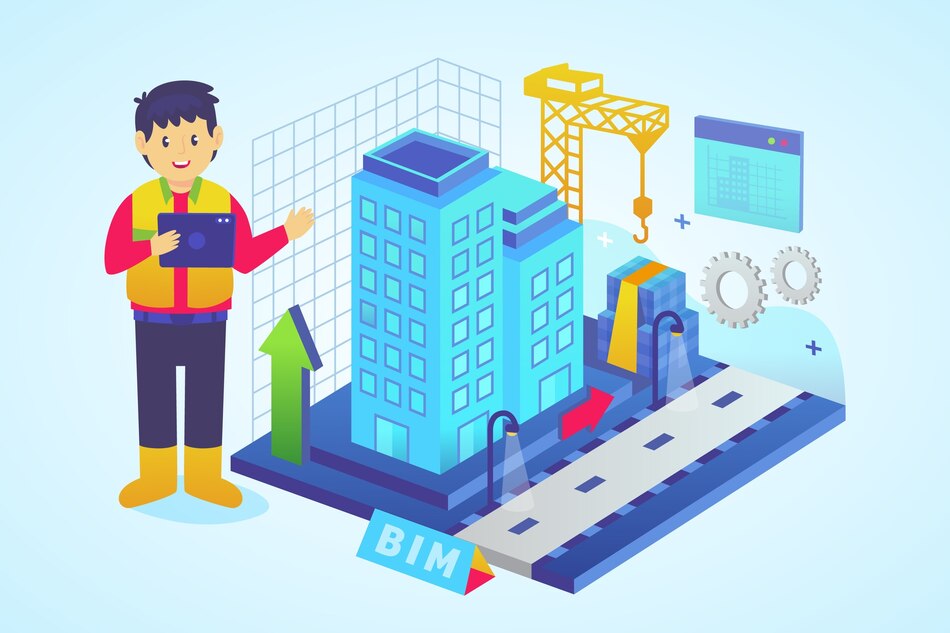Introduction:
Building Information Modeling (BIM) is revolutionizing the architecture, engineering, and construction (AEC) industry. This digital representation of a building’s physical and functional characteristics enables seamless collaboration among stakeholders, enhances project efficiency, and drives innovation. In this blog, we will delve into the numerous benefits of BIM, exploring how it is transforming the AEC industry and setting new standards for project delivery and facility management.
1. Improved Collaboration and Communication:

a. Centralized Data Repository:
- BIM serves as a central repository for all project-related information, including design, construction, and operational data. This centralized approach ensures that all stakeholders have access to the latest information, reducing misunderstandings and errors.
b. Enhanced Collaboration:
- BIM facilitates real-time collaboration among architects, engineers, contractors, and clients. By working on a shared model, stakeholders can easily coordinate and make informed decisions, improving project outcomes.
c. Effective Communication:
- Visual representations and 3D models provided by BIM make it easier to communicate complex design ideas and concepts. This enhances understanding and alignment among team members and clients.
2. Increased Efficiency and Productivity:

a. Streamlined Workflows:
- BIM automates many manual processes, such as quantity take-offs and clash detection. This streamlines workflows, reduces repetitive tasks, and allows teams to focus on higher-value activities.
b. Reduced Rework:
- By identifying and resolving clashes and conflicts early in the design phase, BIM minimizes rework during construction. This not only saves time but also reduces costs associated with material wastage and labor.
c. Better Project Management:
- BIM provides project managers with detailed schedules, cost estimates, and resource plans. This enables better planning, monitoring, and control of project activities, leading to timely and within-budget delivery.
3. Enhanced Design Quality and Innovation:

a. Design Visualization:
- BIM enables the creation of detailed 3D models that provide a realistic visualization of the final building. This helps designers experiment with different design options, materials, and layouts to achieve optimal results.
b. Parametric Design:
- BIM supports parametric design, allowing designers to easily modify parameters and see the impact on the entire model. This flexibility fosters creativity and innovation, leading to better design solutions.
c. Sustainability and Performance Analysis:
- BIM integrates with various analysis tools to evaluate the building’s energy performance, daylighting, and thermal comfort. This promotes the design of sustainable buildings that meet environmental standards.
4. Cost and Time Savings:

a. Accurate Cost Estimation:
- BIM provides accurate quantity take-offs and cost estimates based on the detailed model. This reduces the risk of budget overruns and ensures that the project remains financially viable.
b. Time Optimization:
- The ability to visualize and simulate construction sequences in BIM helps identify potential delays and optimize schedules. This ensures that the project stays on track and is completed on time.
c. Reduced Change Orders:
- By detecting and resolving issues early, BIM minimizes the need for change orders during construction. This reduces disruptions and keeps the project moving forward smoothly.
5. Improved Facility Management and Maintenance:
a. Lifecycle Management:
- BIM extends beyond the design and construction phases, supporting the entire lifecycle of the building. Facility managers can use BIM data for maintenance planning, asset management, and operational efficiency.
b. Predictive Maintenance:
- BIM integrates with sensors and IoT devices to monitor the building’s performance in real-time. This enables predictive maintenance, where potential issues are identified and addressed before they escalate into costly repairs.
c. Enhanced Space Utilization:
- BIM provides detailed information on space usage, occupancy levels, and energy consumption. This helps facility managers optimize space utilization and reduce operational costs.
6. Compliance and Risk Management:
a. Regulatory Compliance:
- BIM helps ensure compliance with building codes and regulations by providing accurate documentation and reports. This reduces the risk of non-compliance and associated penalties.
b. Risk Mitigation:
- By simulating various scenarios and analyzing potential risks, BIM enables proactive risk management. This ensures that risks are identified, assessed, and mitigated early in the project.
c. Health and Safety:
- BIM enhances health and safety by visualizing construction sequences, identifying hazards, and planning safe workflows. This promotes a safer working environment and reduces accidents on site.
7. Enhanced Client Satisfaction:
a. Transparent Processes:
- BIM provides clients with clear and transparent project information, including progress updates, cost estimates, and timelines. This builds trust and ensures that clients are well-informed throughout the project.
b. Realistic Visualizations:
- The ability to visualize the final building in 3D helps clients understand the design and provide feedback. This ensures that their expectations are met and that the final product aligns with their vision.
c. Value-Added Services:
- BIM enables the delivery of value-added services, such as virtual walkthroughs, augmented reality experiences, and detailed facility management plans. This enhances the overall client experience and satisfaction.
Conclusion:
Building Information Modeling (BIM) is a game-changer for the AEC industry, offering a myriad of benefits that enhance collaboration, efficiency, and innovation. From improved design quality and cost savings to better facility management and client satisfaction, BIM transforms how projects are delivered and maintained. As technology continues to evolve, the adoption of BIM will become even more crucial for staying competitive and achieving project success. Embracing BIM is not just a trend; it is a strategic imperative that drives the future of the AEC industry.
Frequently Asked Questions (FAQs) – Benefits of BIM:
1. What is Building Information Modeling (BIM)?
- BIM is a digital representation of a building’s physical and functional characteristics, enabling seamless collaboration among stakeholders throughout the project lifecycle.
2. How does BIM improve collaboration in the AEC industry?
- BIM provides a centralized data repository and facilitates real-time collaboration, ensuring that all stakeholders have access to accurate and up-to-date information.
3. What are the key benefits of using BIM for design quality?
- BIM enhances design quality through realistic visualization, parametric design, and performance analysis, allowing for optimal design solutions and sustainable buildings.
4. How does BIM contribute to cost and time savings?
- BIM provides accurate cost estimation, optimizes project schedules, and reduces rework and change orders, resulting in significant cost and time savings.
5. How does BIM support facility management?
- BIM extends to the operational phase, providing data for maintenance planning, predictive maintenance, and enhanced space utilization, improving overall facility management.
6. What role does BIM play in risk management and regulatory compliance?
- BIM helps identify and mitigate risks, ensures compliance with building codes, and promotes health and safety through detailed documentation and visualization of construction sequences.
7. How does BIM enhance client satisfaction?
- BIM provides clients with transparent processes, realistic visualizations, and value-added services, ensuring that their expectations are met and their experience is enhanced.








